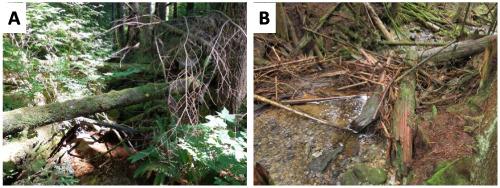当前位置:
X-MOL 学术
›
Earth Surf.Process. Land.
›
论文详情
Our official English website, www.x-mol.net, welcomes your
feedback! (Note: you will need to create a separate account there.)
Decadal‐scale changes in suspended wood after riparian recruitment in managed stands in headwater streams of coastal British Columbia, Canada
Earth Surface Processes and Landforms ( IF 2.8 ) Pub Date : 2020-04-15 , DOI: 10.1002/esp.4859 Felipe Rossetti de Paula 1, 2 , John S. Richardson 1 , Alex C.Y. Yeung 1 , Stephen J. Mitchell 1 , Devesh Bahuguna 3
Earth Surface Processes and Landforms ( IF 2.8 ) Pub Date : 2020-04-15 , DOI: 10.1002/esp.4859 Felipe Rossetti de Paula 1, 2 , John S. Richardson 1 , Alex C.Y. Yeung 1 , Stephen J. Mitchell 1 , Devesh Bahuguna 3
Affiliation

|
Large wood (LW) affects several ecological and hydrogeomorphic processes in streams. The main source of LW is riparian trees falling inside channels. However, in confined valley floors, falling trees are more likely to be suspended above the channel. Eventually, these suspended trees will decompose and break to finally fall into the channel to better provide functions for streams. We evaluated changes in wood decay, length, diameter, and suspended status (suspended or non‐suspended) 17 years post‐harvest and nine years after the first sampling occurred in 2006 in 12 headwater streams of coastal British Columbia, Canada. We also evaluated whether changes differed among riparian management treatments (no‐harvest buffers of 10 and 30 m in width, thinning, and unharvested reference sites), and identified the factors affecting wood changes and suspended status. Wood pieces advanced in decay, became shorter, and 34% of them (n = 108) changed status from suspended to non‐suspended. Non‐suspended wood pieces were more decayed and shorter than suspended wood. Suspended wood was longer, thicker, less decayed, and represented 46.5% (n = 147) of the wood sampled in 2006. Our findings revealed limited influences of riparian management on many aspects of wood changes considered in this study. Changes in wood characteristics were more likely for pieces that were smaller in diameter, longer, and suspended closer to the water. The transition from suspended to non‐suspended LW can be a long‐term process that can increase wood residence time and reduce LW in‐stream functions particularly in confined stream valleys. The suspended stage is also an important mechanism underlying time lags in stream ecosystem responses to riparian tree fall. © 2020 John Wiley & Sons, Ltd.
中文翻译:

在加拿大不列颠哥伦比亚省沿海源头溪流的受管理林分中,河岸边募集后悬浮木材的年代尺度变化
大型木材(LW)影响河流中的几种生态和水文地理过程。LW的主要来源是河道内的河岸树木。但是,在狭窄的山谷地板中,倒下的树木更有可能悬挂在河道上方。最终,这些悬挂的树将分解并破裂,最终落入通道中,以更好地为流提供功能。我们评估了收获后17年和2006年首次采样在加拿大不列颠哥伦比亚省沿海的12条源头溪流中木材腐烂,长度,直径和悬浮状态(悬浮或未悬浮)的变化(悬浮或未悬浮)。我们还评估了河岸管理措施之间的变化是否有所不同(宽度为10和30 m的无收获缓冲区,稀疏和未收获的参考地点),并确定了影响木材变化和悬浮状态的因素。木质碎片逐渐腐烂,变短,其中34%(n = 108)将状态从“已暂停”更改为“未暂停”。非悬浮的木块比悬浮的木块更易腐烂且更短。悬浮木材更长,更厚,腐烂程度更小,占46.5%(n= 147)2006年取样的木材。我们的研究结果表明,河岸带管理对本研究中考虑的许多木材变化方面的影响有限。直径较小,长度较长且悬挂在靠近水面的木材更有可能发生木材特性变化。从悬浮的LW过渡到非悬浮的LW可能是一个长期过程,可能会增加木材停留时间并减少LW的河内功能,尤其是在狭窄溪谷中。悬浮阶段也是河流生态系统对河岸树木倒塌反应的时间滞后的重要机制。©2020 John Wiley&Sons,Ltd.
更新日期:2020-04-15
中文翻译:

在加拿大不列颠哥伦比亚省沿海源头溪流的受管理林分中,河岸边募集后悬浮木材的年代尺度变化
大型木材(LW)影响河流中的几种生态和水文地理过程。LW的主要来源是河道内的河岸树木。但是,在狭窄的山谷地板中,倒下的树木更有可能悬挂在河道上方。最终,这些悬挂的树将分解并破裂,最终落入通道中,以更好地为流提供功能。我们评估了收获后17年和2006年首次采样在加拿大不列颠哥伦比亚省沿海的12条源头溪流中木材腐烂,长度,直径和悬浮状态(悬浮或未悬浮)的变化(悬浮或未悬浮)。我们还评估了河岸管理措施之间的变化是否有所不同(宽度为10和30 m的无收获缓冲区,稀疏和未收获的参考地点),并确定了影响木材变化和悬浮状态的因素。木质碎片逐渐腐烂,变短,其中34%(n = 108)将状态从“已暂停”更改为“未暂停”。非悬浮的木块比悬浮的木块更易腐烂且更短。悬浮木材更长,更厚,腐烂程度更小,占46.5%(n= 147)2006年取样的木材。我们的研究结果表明,河岸带管理对本研究中考虑的许多木材变化方面的影响有限。直径较小,长度较长且悬挂在靠近水面的木材更有可能发生木材特性变化。从悬浮的LW过渡到非悬浮的LW可能是一个长期过程,可能会增加木材停留时间并减少LW的河内功能,尤其是在狭窄溪谷中。悬浮阶段也是河流生态系统对河岸树木倒塌反应的时间滞后的重要机制。©2020 John Wiley&Sons,Ltd.











































 京公网安备 11010802027423号
京公网安备 11010802027423号